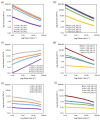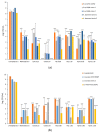Alcohol-Based Hand Sanitizers: Does Gelling Agent Really Matter?
- PMID: 35200468
- PMCID: PMC8871833
- DOI: 10.3390/gels8020087
Alcohol-Based Hand Sanitizers: Does Gelling Agent Really Matter?
Abstract
Hand hygiene, social distancing, and face covering are considered the first protection against Coronavirus spreading. The high demand during the COVID-19 emergency has driven a frenetic production and marketing of hand sanitizer gels. Nevertheless, the effect of the gelling agent and its amount on the effectiveness of alcohol-based hand sanitizers (ABHSs) needs to be clarified. We presented a systematic study on the effect of the characteristics and concentration of the most employed excipients on the properties and antimicrobial activity of ABHSs. Three different gelling agents, carbopol, hydroxypropylmethylcellulose (HPMC), and hydroxyethylcellulose (HEC), at four different concentrations were used to prepare ABHSs. Viscosity, spreadability, delivery from commercial dispensers, evaporation rate, rubbing time, and hand distribution of the ABHSs were then explored. Biocidal activity of selected ABHSs was evaluated in vitro on ATCC and clinical strains. The studied ABHS can be considered bioactive and comfortable. Nevertheless, the cellulose polymers and ethanol interactions led to a slight but significant reduction in the biocidal activity compared with carbopol-based formulations. Our results underline the importance of the gelling agent properties and support the choice of carbopol as one of the best thickener agents in ABHS formulations.
Keywords: COVID-19; alcohol-based hand sanitizers; thickener agents.
Conflict of interest statement
The authors declare no conflict of interest.
Figures











Similar articles
-
Alcohol-based Hand Sanitizers amid COVID-19: Chemical Formulation, Analysis, Safety.ChemistrySelect. 2022 Dec 6;7(45):e202203290. doi: 10.1002/slct.202203290. Epub 2022 Dec 1. ChemistrySelect. 2022. PMID: 36718183 Free PMC article.
-
Formulation and Evaluation of Alcohol-Free Hand Sanitizer Gels to Prevent the Spread of Infections during Pandemics.Int J Environ Res Public Health. 2021 Jun 9;18(12):6252. doi: 10.3390/ijerph18126252. Int J Environ Res Public Health. 2021. PMID: 34207817 Free PMC article.
-
COVID-19, Overzealous Sanitizer Use, and Hair Discoloration: Case Reports.Acta Dermatovenerol Croat. 2022 Jul;30(1):57-58. Acta Dermatovenerol Croat. 2022. PMID: 36153721
-
Alcohol-based hand sanitizer - composition, proper use and precautions.Germs. 2021 Sep 29;11(3):408-417. doi: 10.18683/germs.2021.1278. eCollection 2021 Sep. Germs. 2021. PMID: 34722363 Free PMC article. Review.
-
Assessment of ethanol exposure from hand sanitizer use and potential for developmental toxicity in nursing infants.J Appl Toxicol. 2022 Sep;42(9):1424-1442. doi: 10.1002/jat.4284. Epub 2022 Feb 2. J Appl Toxicol. 2022. PMID: 34991177 Free PMC article. Review.
Cited by
-
Control of Healthcare-Associated Carbapenem-Resistant Acinetobacter baumannii by Enhancement of Infection Control Measures.Antibiotics (Basel). 2022 Aug 8;11(8):1076. doi: 10.3390/antibiotics11081076. Antibiotics (Basel). 2022. PMID: 36009945 Free PMC article.
-
Purification and use of crude green glycerol from the transesterification of triglycerides in the formulation of an alcohol gel hand sanitizer.Sci Rep. 2024 Mar 6;14(1):5510. doi: 10.1038/s41598-023-49422-5. Sci Rep. 2024. PMID: 38448502 Free PMC article.
References
-
- World Health Organization . World Alliance for Patient Safety: Forward Programme, 2005. World Health Organization; Geneva, Switzerland: 2004.
-
- World Health Organization (WHO) WHO Guidelines on Hand Hygiene in Health Care: First Global Patient Safety Challenge Clean Care Is Safer Care. World Health Organization; Geneva, Switzerland: 2009. - PubMed
LinkOut - more resources
Full Text Sources

